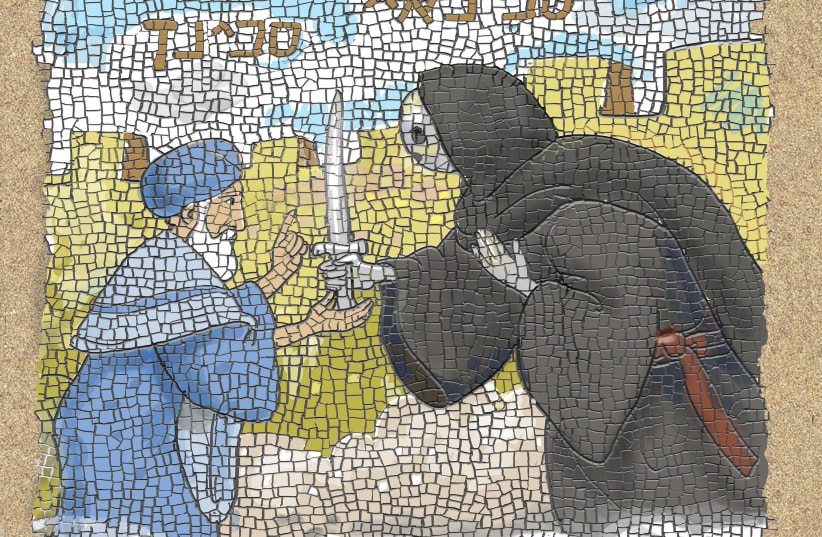
Longfellow’s is a deeper, darker tale, in which Rabbi Yehoshua Ben Levi encounters the Angel of Death and, after a tussle, scores a sort of victory over him. In the process, he becomes one of the few human beings to enter Paradise while still alive.
Rabbi Ben Levi is mentioned dozens of times in Talmudic literature as an authority on Jewish law, and around the year 200 CE he was included in the assembly of great scholars gathered together by Rabbi Yehuda HaNasi to create the compilation of Jewish law later known as the Mishna. The legend of his encounter with the Angel of Death appears not only in the Talmud, but in dozens of other versions in many cultures, including even the Koran.
Just a few years ago, on a hillside facing the remains of ancient Zippori, a cave tomb was discovered bearing the inscription “Here is the tomb of Rabbi Yehoshua Ben Levi.” Inside were niches for six tombs. Five contained the untouched remains of the original occupants, nearly 2,000 years old. One was empty, its inhabitant long gone or never there. Earlier this year celebrated Israeli artist Avi Katz, whose illustrations graced the pages of The Jerusalem Report for many years, designed a mosaic mural overlooking Rabbi Ben Levi’s tomb in Zippori which illustrates the legend associated with him.
Now, in a truly spectacular artistic endeavor, Katz’s mosaics are married to Longfellow’s poem to create a ravishingly beautiful volume. At the heart of The Legend of Rabbi Ben Levi are 12 mosaics by Avi Katz, presented full page and in stunning color, illustrating Longfellow’s poetic narrative as it unfolds. Distinguished science fiction writer Lavie Tidhar provides a foreword in which he connects the Ben Levi legend to the perception of miracles in Jewish folk lore, and invites readers to marvel at the gorgeous art his story has inspired.
At the rear of the volume is a background article penned by Israeli writer Mitch Pilcer. US-born Pilcer and his wife came to Zippori in 1991 and found land on an abandoned hillside. They repaired a ruined house on the site, and began a dual business – farming and hospitality. They planted pomegranate and olive trees and made honey and wine. At the same time they built guest houses for people to come and visit the brand new Zippori National Park, which had opened on the hillside facing them.
In 2009, while clearing stones from a terrace, they uncovered the opening to a cave. The entrance was protected by an inscribed stone door with the words, “Here is the tomb of Rabbi Yehoshua Ben Levi.” That discovery was the prelude to years of trouble for the Pilcers. They were taken to court by the Israel Antiquities Authority, charged with illegal archaeological activity, and a well-publicized struggle ensued.
Because the legend of Rabbi Ben Levi is so well known, hundreds of visitors were attracted to the tomb entrance which, in the light of the story surrounding his name, was perceived by many to be the gateway to paradise. The popularity of the site showed no signs of diminishing, and finally an accommodation was reached. The IAA unblocked the cave and restored the stone door it had appropriated. The Pilcers pledged to allow access to all visitors who wished to come to the site.
Pilcer’s article provides both a scholarly and a personal account of how and why the tomb of Rabbi Yehoshua Ben Levi remains as vivid in the Jewish imagination as it has done for some 2000 years. So vivid indeed, that in a video available on YouTube a gentleman, bearded and in casual timeless dress, stands by the tomb claiming to be Rabbi Yehoshua Ben Levi himself, given the opportunity after 1800 years “to show myself once again in this world.” Pilcer’s article is, however, the icing on a most splendid cake. It is a genuine pleasure to turn the pages, gaze at Avi Katz’s mosaics, and marvel not only at his artistry, but at that of the poet Longfellow, who tells the story of Rabbi Ben Levi in such memorable lines. This is a book to treasure indeed.The Legend of Rabbi Ben Levi
Henry Wadsworth Longfellow, illustrated by Avi Katz
Gefen Publishing House, 2020
$14.95; 32 pages (hardcover)
